Power in Your Words: Crafting GOTV Messages That Spark Action
Inspire more people to sport “I Voted” stickers with these proven SMS strategies to get out the vote

Over the past several years, chances are you’ve encountered a text message or two (or three) from a political campaign or other organization around election time. Campaigns and text marketing have emerged as a winning pair in the world of voter mobilization, also known as GOTV (or get out the vote). With sky-high open rates for SMS, it makes sense that organizations are leveraging the power of text marketing.
Read on to uncover six strategies for SMS messages to GOTV and encourage people to make their voices heard.
What Is GOTV?
"Get out the vote" (GOTV) refers to efforts and strategies to encourage eligible voters to participate in elections and cast their ballots. These campaigns aim to mobilize registered individuals to vote and ensure that they actually show up on election day or participate in early voting or absentee balloting. You might have heard of the term “voter turnout”; GOTV is all about increasing voter turnout through various channels, like social media, email, phone calls, and text messages.
So, who helps to get out the vote? Political campaigns, voter turnout organizations, individual political parties, and even college student groups initiate GOTV campaigns.
Effective Formats for GOTV Messaging
What are some effective formats for GOTV messaging? Some effective formats for GOTV messaging are:
- SMS messages: With high open rates, text messages are ideal for time-sensitive GOTV reminders, personalized calls to action, and interactive elements.
- Email messages: Use email to provide your audience with longer-form content, including storytelling, candidate information, and more. (Learn more about SMS vs. email marketing.)
- Social media: Boost community engagement and display compelling visuals with social media GOTV messages.
- Phone calls: While phone calls can often be seen as spam, some age groups might prefer a GOTV phone call over a text or email.
While all of these channels should be used for your campaign, we focus on GOTV texting in this article.
How to Use GOTV Text Messages in Your Campaign
Now that you know what GOTV is, you’re probably wondering what get-out-the-vote tactics are most successful. Here are strategies that can inspire and motivate. And don’t forget to check out our tips on SMS alerts post-election.
#1

Promote Voter Registration
Your GOTV texting strategy should start by ensuring that constituents are registered to vote, and if they aren’t, helping them register. Start this portion of your campaign at least a month before Election Day.
If you need to grow your SMS contact list before you begin your campaign, share a dedicated keyword on your social channels and website that people can text to your number. Then, they can opt into your contact list.
#2
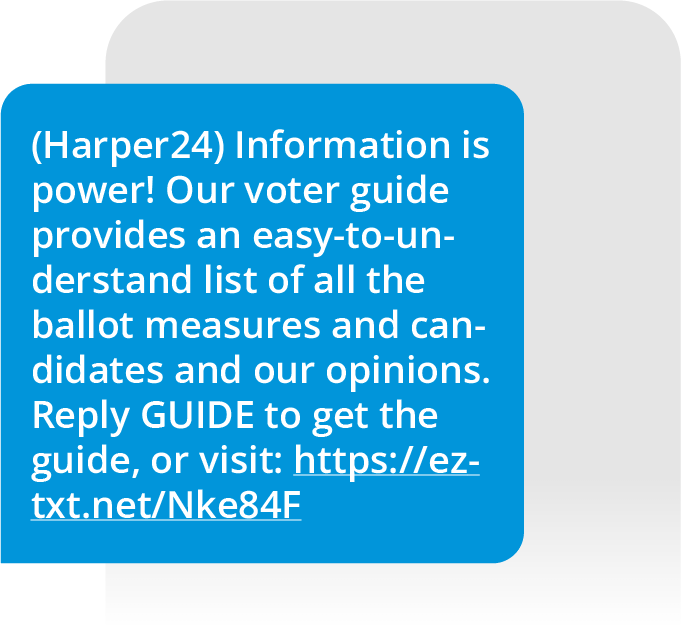
Advertise Voter Guides
Election seasons can be overwhelming. People are bombarded with political flyers, TV and radio ads, and nonstop chatter about which friend likes which candidate and why. Your organization needs to make it easy for contacts to access your own voter guide or an approved one. Don’t let them swim in a sea of indecision due to too much information. GOTV voter guide messages can help people understand the issues and feel confident in their views.
#3
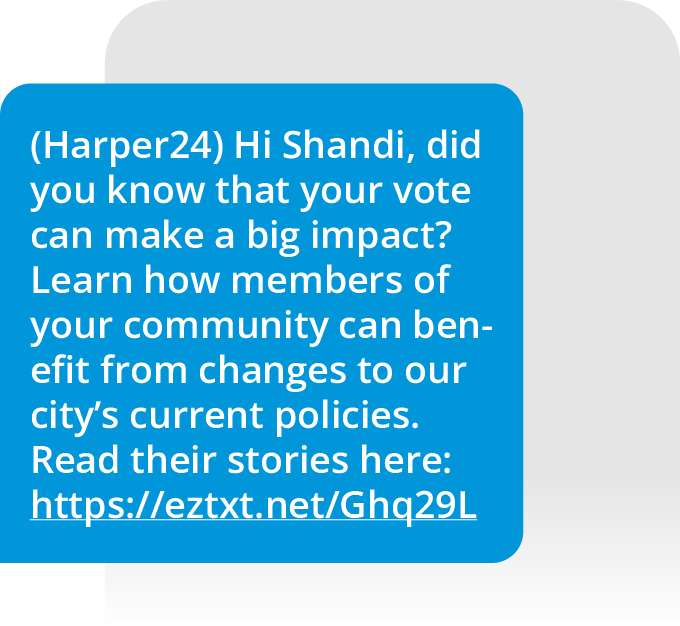
Share Real Stories
Another way to cut through the noise of political campaign messaging is to share real-life stories with voters. You’re probably wondering, “How can I use storytelling to motivate voters?” You can use storytelling to motivate voters by sharing personal experiences that led you to your current beliefs and values. Doing so helps provide voters with more context about you as a candidate, the issues you stand by, and the campaign. You could also harness the power of other voters’ or community members’ stories (with their consent) impacted by current policies.
Storytelling drives home the issues you care about and shows how voting can make a tangible difference.
#4
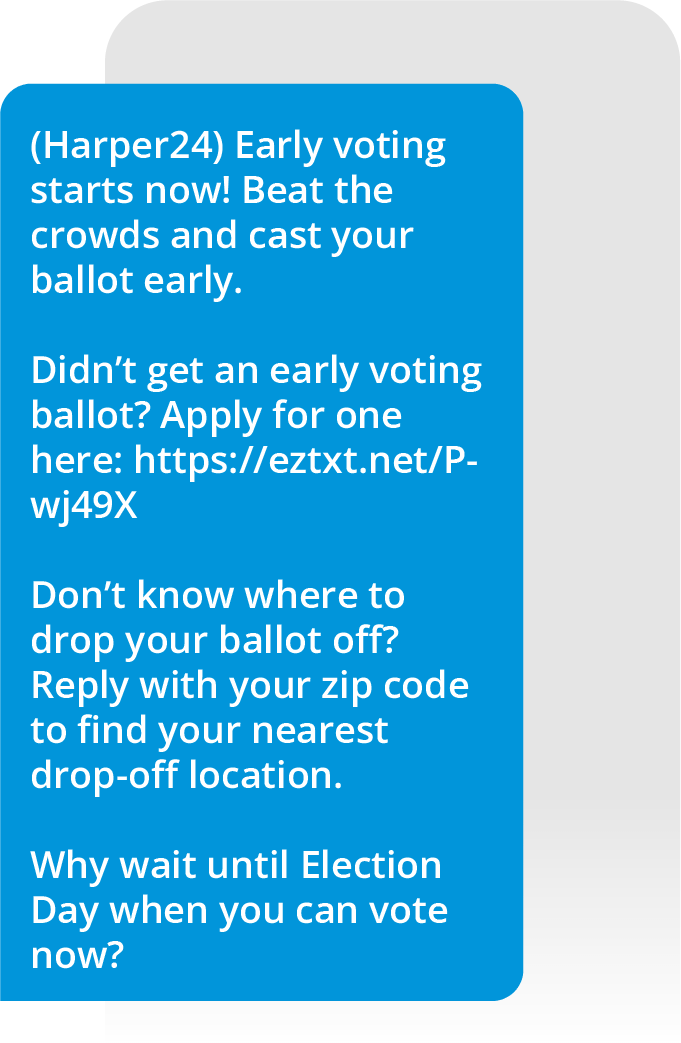
Prompt Early Voting
Some states allow early voting, while some don’t, so this strategy might not be broadly applied. Another caveat is that early voting starts on different days in different states. Confused yet? Basically, if the state where you’re trying to apply GOTV messaging efforts has early voting, it’s important to capitalize on that. Proponents of early voting note that it helps more people vote (who might not be able to make it on polling day) and cuts wait times at the polls.
#5
Get Interactive
With the vast amounts of information sent their way, voters can sometimes become apathetic. After all, information overload is real. One way to reach voters is by including interactive GOTV tools in your campaign messaging. What are some innovative ways to use technology for GOTV messaging? Here are some examples of innovative ways to use technology for GOTV messaging:
- Interactive surveys/quizzes: Engage voters by asking them to participate in text surveys or quizzes about hot-button issues, what they want to see changed in their community, and even preferences on the types of messages they receive from your GOTV campaign. Learn more about how to send surveys via text.
- Augmented reality: Craft interactive experiences for your audience that they can access through your SMS messages and other channels. With augmented reality, political candidates can provide personalized campaign materials and real-time campaign events, allowing for a more immersive voting experience.
#6

Provide Election Day Information
About a week before Election Day, send out GOTV text messages to your contact base with polling day info, like the date, times, polling locations, and what they need to bring (most states require some form of identification to vote). Then, using SMS automation, schedule another GOTV Election Day text to be sent the day before polling.
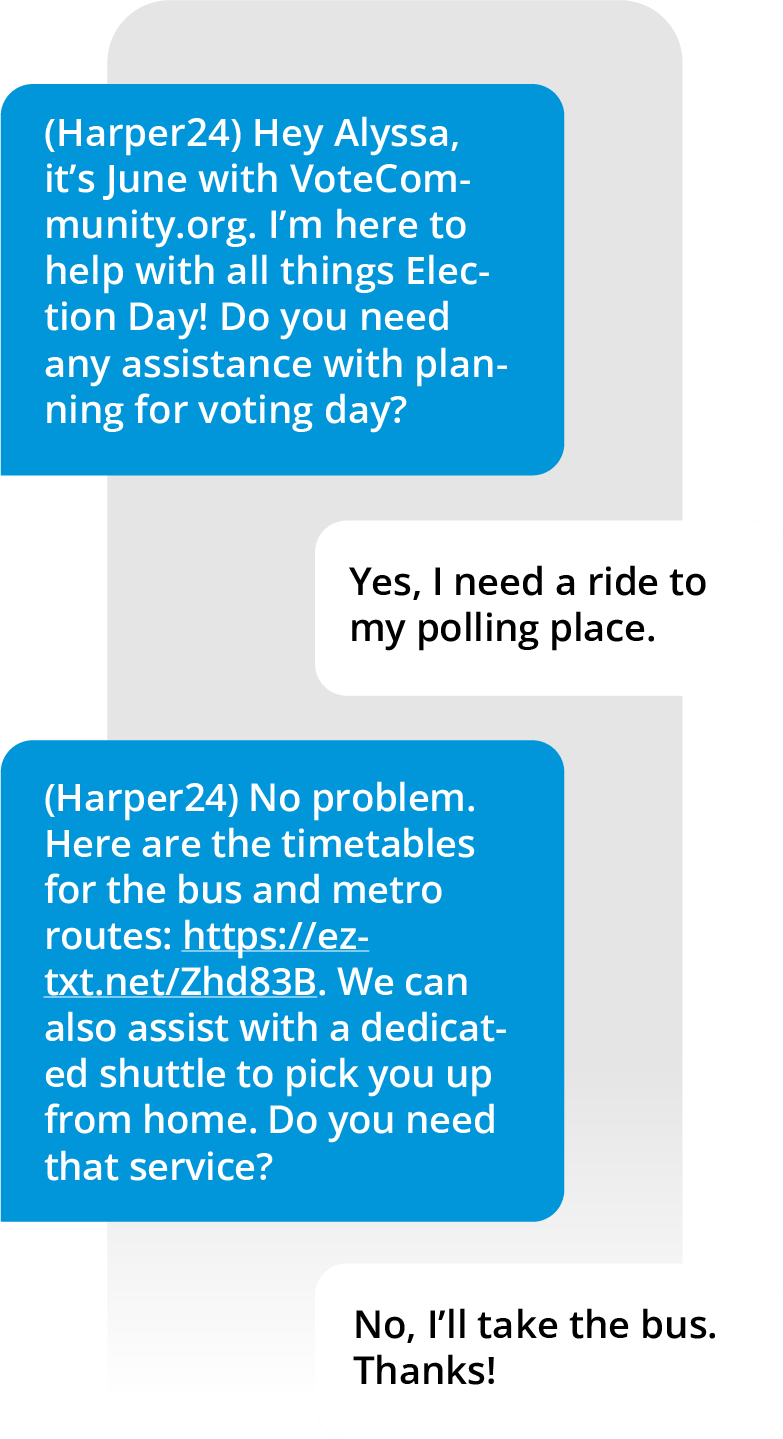
#7
Assist with Election Day Planning
In addition to Election Day info, some people might need assistance with planning for transportation, babysitters, accessibility, and so on. Some advocacy organizations and other types of groups offer this kind of help with their get-out-the-vote efforts. This is a great opportunity to use two-way SMS, where contacts can have one-to-one conversations with you regarding questions, planning information, and more. You could also leverage AI chatbots and virtual assistants for these types of messages. Learn more about AI and text marketing.
#8
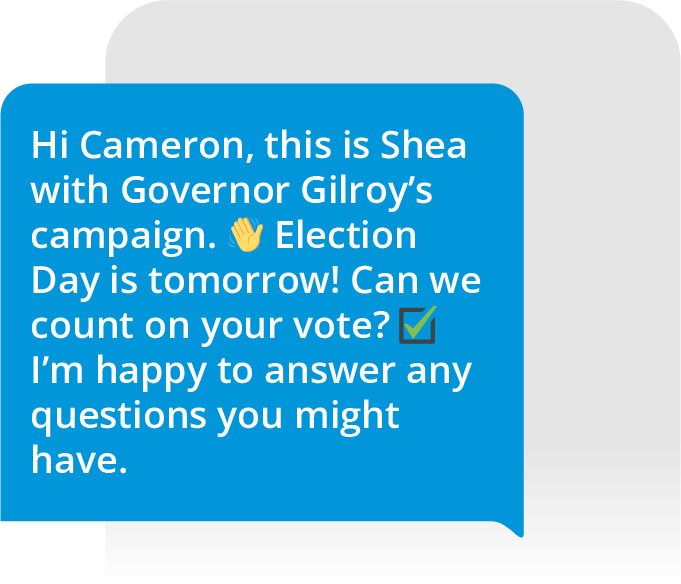
Send an Election Day Reminder
Election Day reminders should be sent the day before and the morning of polling to capture all the last-minute planners. Keep these get-out-the-vote messages short and sweet. If you’re part of a political campaign, now is another perfect time to leverage to ask the contact if you can count on their vote or if they need any additional information before deciding.
GOTV Messaging Mistakes to Steer Clear Of
What are some GOTV messaging pitfalls to avoid? Some GOTV messaging pitfalls to avoid include providing misinformation, including too much information, not segmenting your contacts, and not tracking metrics. Let’s review each one.
Misinformation
Providing misinformation in your GOTV campaign erodes trust and can undermine elections. Always stick to the facts.
Information Overload
As mentioned, voters are bombarded with information via mail, texts, email, social media, and phone calls during election cycles. While it is important to get your message out using the above strategies, optimize your texts for success by ensuring that your campaign only includes necessary and impactful information. Another way to prevent information overload is to send messages at the right times and only frequently enough to capture interest.
Not Segmenting Your Contacts
Segmentation is one of the best ways to ensure that each contact is receiving personalized information that is relevant to them. This raises the question, “How can I tailor my GOTV messages to different voter groups?” You can tailor GOTV messages to different voter groups by segmenting them based on demographics, interests, voting history, and location. This helps your campaign speak to their specific concerns and motivations, using language that resonates with them.
Segmenting contacts also means that you can strike the right tone in your messages — something that is important for keeping voters engaged, not turning them away.
One question that often arises for many campaigns regarding the tone of voice is, “how can I use humor or emotions to connect with voters in my GOTV messages?” Use humor or emotions to connect with voters in GOTV messages when appropriate. For example, you might be able to strike a more humorous tone in messages sent to millennial or Gen Z voters, while senior voters might not appreciate humor in GOTV messages. And feel free to harness the power of emotions in messages that focus on personal or community stories but perhaps omit it from Election Day reminders.
Not writing for your audience is one of the texting errors organizations make daily. Keep this in mind: the tone will depend on the voter's age and the type of message.
Not Tracking Metrics
A campaign without checking GOTV analytics won’t be very successful. That’s because you need to know how your messages and outreach efforts perform. You might wonder, “How can I track the effectiveness of my GOTV messages?”
To track the effectiveness of your GOTV messages, you should monitor click-through rates, bounce rates, responses to surveys/quizzes, and other contact behavior. Use this data to understand which messages resonate best (and don’t) and adapt your strategy accordingly. You can integrate EZ Texting’s reporting and analytics tools with your digital political tools for a more holistic view of your overall campaign.
Get Out The Vote With EZ Texting
Make your GOTV strategies seamless and scalable with EZ Texting. We offer bulk texting and easy contact management to ensure that your contacts receive personalized messages at the right time — which is crucial for SMS marketing for government entities and political organizations. Sign up with EZ Texting today!
FAQs
The key elements of a powerful GOTV message are personalization, urgency, providing accurate information, and highlighting why voting matters. Some messages should include emotion or even humor to engage voters.
You can involve volunteers in crafting and delivering GOTV messages by asking them to tap into their stories and experiences for inspiration. They could share these stories in personalized messages to friends and family or simply use them as part of brainstorming sessions for engaging content. GOTV volunteers can also help with translation and outreach to diverse communities.
To learn about some inspiring examples of successful GOTV campaigns, research past elections and local, state, or national campaigns that are known for their effective GOTV strategies. Some specific things to look for are how they tweaked messages to different voter groups, how they used technology to engage their audience, and other GOTV tactics.
See other resources related to:

